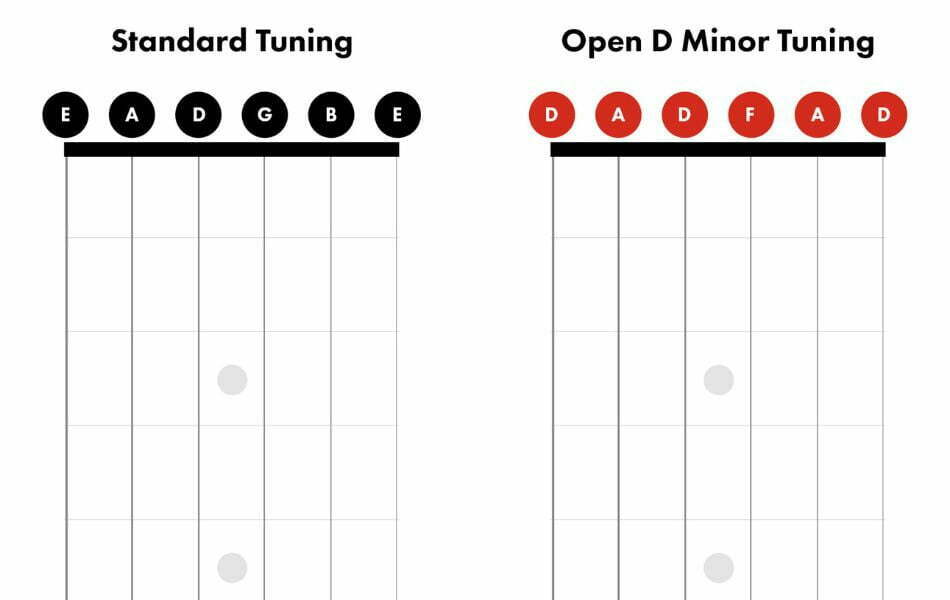In the world of guitar playing, chords are the building blocks of melodies and harmonies. Among the myriad of chords that exist, the open D minor chords hold a special place. In this guide, we’ll delve into the intricacies of the open D minor chord – its structure, finger placement, variations, and its potential to convey a wide range of emotions through your music.
Contents
How to tune your guitar in open D
Learning to tune by ear is an essential skill. Still, especially at the beginning, it’s recommended to utilize a guitar tuner until you become familiar with the sound of the open D chord. To tune your guitar to Open D by ear from the standard tuning, follow these step-by-step instructions:
Begin by playing the open 4th string (D) and lower the 6th string down a whole step. Match the 6th string to the pitch of the 4th string, so it resonates an octave lower than the 4th.
Now, play the 4th string once again and lower the 1st string down a whole step from E to D. This will create uniformity with three D notes on the 6th, 4th, and 1st strings. Aim to achieve harmony among these three D notes.
Once you’ve aligned the D notes, proceed to fine-tune the 3rd string. Lower it a half step from G to F#. You can accomplish this adjustment by turning the tuning peg approximately a quarter turn.
As a final step, strum all the open strings and listen carefully for any discrepancies in the sound of the D chord. Pay close attention to any imperfections in the harmony and make any necessary adjustments.
This method of tuning will enable you to achieve the distinctive sound of the open D chord. As you continue to practice and develop your ear for pitch, you’ll gain confidence in tuning your guitar accurately by ear.

What is an open D minor chords
An open D minor chord is a guitar chord played in open position that consists of the notes D, A, D, F, A, and D. It is formed by strumming all the open strings on the guitar, resulting in a D minor chord sound. Here’s how to play the open D minor chord:
- String-by-String Finger Placement:
- Place your index finger on the 1st fret of the high E (1st) string.
- Leave the A (5th) string open.
- Place your middle finger on the 2nd fret of the D (4th) string.
- Place your ring finger on the 3rd fret of the B (2nd) string.
- Leave the G (3rd) string open.
- Leave the low E (6th) string open.
Strumming:
Strum from the D (4th) string down to the high E (1st) string.
When you strum the open strings with this finger placement, you create the sound of open D minor chords. Remember to maintain proper finger positioning for clear and clean sound. Practice changing to and from other chords to improve your chord transition skills.
The open D minor tuning has a somber and melancholic quality, making it suitable for songs or progressions that evoke these emotions.

Some open D minor chords
Basic basic Open D Minor Chord
Index finger on the 1st fret of the high E (1st) string.
Middle finger on the 2nd fret of the D (4th) string.
Ring finger on the 3rd fret of the B (2nd) string.
Strum from the D (4th) string down to the high E (1st) string.
Dm Chord with Open A
Leave the A (5th) string open.
The middle finger on the 2nd fret of the D (4th) string.
Ring finger on the 3rd fret of the B (2nd) string.
Strum from the A (5th) string down to the high E (1st) string.
Dm Chord with High F
Index finger on the 1st fret of the high E (1st) string.
The middle finger on the 2nd fret of the D (4th) string.
Ring finger on the 3rd fret of the B (2nd) string.
Pinky finger on the 3rd fret of the high E (1st) string.
Strum from the D (4th) string down to the high E (1st) string.
Dm Chord with Low D
Index finger on the 1st fret of the high E (1st) string.
The middle finger on the 2nd fret of the D (4th) string.
Ring finger on the 3rd fret of the B (2nd) string.
Use your thumb to press the 3rd fret of the low E (6th) string.
Strum from the low E (6th) string down to the high E (1st) string.
So pick up your guitar, position your fingers, and let the hauntingly beautiful sound of the open D minor chords become a powerful tool in your musical toolbox. With dedication and practice, you’ll not only master this chord but also create captivating musical moments that resonate with both you and your audience.
